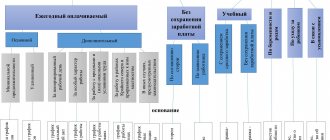The document on the basis of which employees are granted leave of one type or another is an order. It is important to draw it up correctly in order to avoid both problems with inspection authorities and misunderstandings with the hired person in the future. In this article we will talk about the rules by which the document is formed and its features when granting leaves of various types. You will also find a sample vacation order here.
Payroll and personnel records
Basic Rules
In accordance with the Labor Code of the Russian Federation, other Russian laws, an employment contract and internal regulations, the employer provides the hired person with various types of leave. The algorithm for their design is approximately the same:
- we receive an application from the employee (not required if leave is provided according to a schedule), and in some cases additional documents;
- we issue a vacation order;
- we sign it with the manager;
- we introduce him to the employee against his signature;
- We transfer a copy to the accounting department to calculate payment.
Whatever the leave may be - annual paid, without pay, maternity leave or otherwise - before it begins, an order is drawn up to grant leave to the employee. This is a local regulation that gives a person the right to be absent from the workplace for a specified period of time for a specific reason.
Who can receive additional paid leave in 2021

An employee of a business entity, regardless of whether his employer is a legal entity or an individual entrepreneur, can take additional leave in cases provided for by labor law, or when this is expressly stated in his employment contract.
There are the following categories that can receive additional annual paid leave:
- When an irregular working day is established in the concluded employment contract.
- If a special assessment has established that the employee’s place of work is exposed to harmful and dangerous factors.
- When establishing the special nature of work activity.
- If the employee performs his labor functions in territories classified or equivalent to the Far North.
- When this is directly stated in federal legislation.
Also, additional paid leave can be issued to sports workers, coaches, some teachers, medical workers, as well as employees who took part in combat operations.
The company's management in its local regulations for certain merits, or in cases listed, for example, the Regulations on Leave, may establish such additional leaves for some employees.
Attention! However, this employee’s right must be included in his employment agreement, which should also reflect in what periods additional leave is possible and its duration.
In cases where there is a Collective Agreement between the employer and people working at the enterprise, it can reflect certain professions in the company that can count on additional leave.
If an employee’s right is established by a decision of the organization’s administration, then it is she who must accept it based on the existing production and financial capabilities of the enterprise, the opinion of the trade union body, and the characteristics of the company’s activities.
The employee, in accordance with his decision, can take such leave, or can take it either in full or in part, or receive monetary compensation for this period.
Attention! This right does not apply to all employees. For certain categories, replacement of additional leave is not allowed.
These include:
- workers expecting the birth of a child,
- minor employees,
- as well as company personnel exposed to harmful and dangerous factors at work, according to a special assessment of working conditions (SOUT). In the latter case, the law allows for the replacement of this leave for days that exceed seven days.
How to create an order
Until 2013, the T-6 form was used to issue a vacation order (approved by Resolution of the State Statistics Committee dated January 5, 2004 No. 1). There is no need to use it now. However, it contains all the necessary details, and many employers still use it as a vacation order.
Only a few fields need to be filled in the form, and the order is ready. It reflects the following information:
- Name of the organization;
- order number and date of its preparation;
- Full name of the employee and his personnel number;
- the structural unit in which he works, as well as his position;
- type of leave;
- the period for which the leave was granted, the number of days or the period during which the employee will be absent (depending on the type of leave, blocks “A” and/or “B” are filled in);
- total duration of the vacation period (in block “B”). If only one type of leave is provided, its period must also be duplicated in this line.
An order for granting leave is usually prepared by the HR department. The basis is any document, which depends on the type of vacation. A copy of the approved document is sent to the accounting department. Information about leave based on the order must be entered into the employee’s personal card.
Annual leave
An order for annual paid leave is drawn up based on the vacation schedule. Often employers insist that employees additionally write a leave application. However, if it is provided on schedule, then this is unnecessary. It’s another matter when vacation is granted outside the schedule - this option is possible by agreement of the parties. In this case, the employee must write a statement.
A common question: how many days before vacation should an order be issued? The legislation does not regulate the exact deadline for completing this document. However, Article 123 of the Labor Code of the Russian Federation states that the employee must be informed about the onset of vacation at least 2 weeks in advance. It is up to the employer to decide how exactly to do this. In practice, it has turned out that this function is performed by the order to grant leave to the employee. This means that it must be issued at least 14 days before the start of the vacation.
If it is customary at the enterprise to act differently (for example, the employee is given a notice 2 weeks in advance), then the order can be drawn up later. It is only important to remember that without it, the accounting department will not be able to calculate and transfer vacation pay. Payment must be made no later than 3 days before the start of the vacation. So, in any case, there is no point in delaying the order.
The peculiarity of drawing up an order for granting annual leave to an employee using the T-6 form is that it is necessary to fill out block “A”. You must indicate the number of calendar days the employee is absent, the start and end date of the vacation. The line “for the period of work” is also filled in - it reflects the period for which annual leave is due.
Additional paid leave
Some categories of employees receive additional vacation days. For example, those working in the Far North are entitled to an additional 24 calendar days. And those who work irregular hours are given an additional 3 days. If an employee’s working conditions are considered dangerous and/or harmful, he is entitled to at least 7 additional vacation days annually. The exact duration of such leave must be specified in the employment contract - it depends on the results of a special labor assessment and on industry agreements.
Annual and additional paid leave can be granted consecutively. In this case, in the T-6 form, each of them is indicated separately: in block “A” data on regular leave is reflected, in block “B” – on additional leave. In block “B” the total duration is indicated, that is, the days and periods of both vacations are summed up.
The T-6 form is filled out using the same principle if an employee takes two different types of leave in a row, for example, annual, and then “without pay.”
In what cases is additional leave paid and in what cases is it not?
The law stipulates that additional leave must be paid. If it is not paid, then it is not additional paid leave.
In this case, we can only talk about leave without pay, granted to the employee upon his application with the permission of the administration of the business entity.
They should be distinguished, especially since additional leave is part of the vacation schedule and its provision must be carried out in accordance with it.
Vacation without pay
This type of leave can be issued either on certain grounds or without them, that is, simply at the request of the employee (if the employer agrees). The reasons may be: the birth of a child in the family, the death of a close relative, marriage, studying at a state university or entrance exams. In addition, such leave is provided to disabled people (up to 60 calendar days per year), pensioners (up to 14 days), members of election commissions, family members of military personnel or employees of internal affairs bodies and other categories of workers.
In the above cases, as well as in some others, the employer cannot refuse the employee leave without pay. But only on the condition that he submits the relevant document. For example, when requesting student leave, a certificate of summons from an educational institution is required, when requesting leave by a disabled employee, a certificate of disability, and so on. In some cases, such documents may be provided after the vacation. This applies in particular to birth, death or marriage certificates. After all, the employee will receive these documents later than the period for which he requires a break from work.
If there is no documentary evidence of the need for leave, the employer has the right to refuse it. The issue of providing vacation without payment in the absence of legally established grounds is resolved by agreement of the parties.
To receive leave at his own expense, the employee must write an application. Based on it, as well as on the basis of the submitted documents, an order for leave without pay is issued. The line “for the period of work” is not filled in, since the vacation is not related to the time worked. Instead of block “A”, block “B” is filled in. Here you need to reflect the type of leave (without pay), indicate the number of calendar days, start and end dates. If its necessity is confirmed by a document, its details should also be entered in line “B”. Information about the duration and period of vacation must be duplicated in block “B”.
Additional leave for working pensioners

The only opportunity for them to receive this additional period of rest is if these people belong to the appropriate categories (Far North, for hazardous work conditions, long working hours) or to include conditions regarding this in the employment agreements concluded with them.
In addition, retired employees can take leave without pay for a total duration of two weeks annually. They may use such rest periods if necessary.
Additional leave for disabled people
The Labor Code of the Russian Federation for workers with a disability group determines the increased duration of basic annual leave - 30 days. In addition, they have the right to submit an application to management for leave without pay for a period of up to 60 days per year.
They are not included in the preferential category of citizens who have an additional right to leave. However, the administration of the enterprise, based on its existing financial capabilities, can, through its regulations, provide this period to working disabled people.
Additional leave for this category of citizens can be issued only if they work in conditions recognized as harmful, under conditions of irregular working hours.
In cases where the disability was the result of a work-related injury as a result of an accident in a given company, the employee may be granted additional leave.
Additional leave for health workers in 2021
Paid leave, provided additionally, can be issued only to strictly listed categories of health workers in accordance with the norms of federal regulations.
For example, if a health worker cares for patients diagnosed with AIDS. These employees of medical institutions may receive paid leave of an additional 14 days.
To combatants
Additional leave for combat veterans in 2021 has not been changed. Currently, all employees who have participated in combat operations in their service record are guaranteed by the state the right to additional vacation leave in the amount of 15 days.
They can attach it to the main one, take it separately, or split it into smaller periods. In addition, combatants can also take advantage of unpaid leave for a total duration of up to 35 days per year.
Maternity leave
The basis for maternity leave is a certificate of incapacity for work issued by the antenatal clinic where the pregnant employee is registered. In general, the period of such leave is 70 days before childbirth and the same amount after it. In some cases this period is extended.
In addition to the medical document, the woman must write an application for maternity leave. Sick leave details must be included in the order. As in the case of leave without pay, block “B” is filled in. Block “A” and the line “per period” remain empty.

Holiday to care for the child
This type of leave can be taken not only by the mother, but also by the father, grandmother, grandfather, other relative or guardian. In other words, the one who will care for the child. Leave can be divided into parts and granted to different persons, but in turn, and not simultaneously.
The general period of such leave is until the child turns three years old. For the first year and a half, the caregiver is paid an allowance. In practice, most often the mother takes maternity leave, and it begins immediately after the end of maternity leave.
An order to grant parental leave can also be issued in form T-6. The same fields are filled in as for maternity leave. The basis is the child’s birth certificate and a certificate from the spouse’s place of work stating that he does not use the right to this leave. The specified documents are attached to the application.
Legal standards
The legislative framework regulating all issues related to additional leave is the Labor Code of the Russian Federation, as well as regulations of the employing company. These include:
- Art. 116 of the Labor Code regulates the receipt of leave for persons in unfavorable working conditions, and also allows employers to independently determine the terms and conditions for its provision.
- Art. 117 of the Labor Code obliges to determine the duration and accompanying conditions, taking into account the opinion of the commission regulating labor relations at the enterprise.
- Art. 118 defines the category of citizens whose work is of a special nature and establishes the criteria and terms for granting leave for them.
- Art. 119 defines the right to additional rest for persons with an irregular work schedule.
- Art. 263, 264 regulate the procedure for granting parental leave.
- Art. 321, 322 regulate the right to additional rest for workers of the Far North and equivalent territories.
Let's consider who is entitled to additional leave and on what grounds.
Harmful and dangerous working conditions
Based on Art. 117 of the Labor Code of the Russian Federation, people carrying out their activities in harmful and dangerous conditions are entitled to an additional period of time free from labor obligations with a minimum duration of 7 days and a maximum period of up to 36 days (clause 1 of Government Resolution 870).
These working conditions include:
- Carrying out open-pit or underground mining operations.
- Activities during which there is contact with harmful chemicals and other elements.
A complete list of specializations that fall into the above category is displayed in the “List of industries... with hazardous working conditions...” dated October 25, 1974.
The special nature of work
Based on Art. 118 of the Labor Code of the Russian Federation defines the category of persons who receive the right to paid additional leave:
- Medical workers working for 3 or more years.
- Transport workers.
Irregular working hours
Art. 119 of the Labor Code establishes the need to provide additional leave to employees who operate outside the established schedule.
This regime must be fixed in the employment contract (Article 57 of the Labor Code of the Russian Federation). The minimum duration of additional leave is 3 days, and the maximum is 14. The specific rest period is determined by the employer.
Work in the Far North
Additional leave for this category of workers is regulated by Art. 321 of the Labor Code of the Russian Federation and has a minimum duration of 24 days, and for persons carrying out work in territories equated to the Far North - 16 days.
Art. 322 allows you to combine two annual vacations , however, if their total duration is more than six months, the remaining time is distributed over the next vacation.
Part-time job
Art. 286 considers the features of providing additional leave in a situation where an employee carries out his duties at the workplace in his free time from his main activity.
This type of rest is provided during the same period in which annual paid leave is provided at the main workplace.
In case of occupational illness
For employees who receive illness or disability as a result of an emergency at work or due to conditions at work, the employer is obliged to provide additional time, which will be spent on restoring their health in a sanatorium, including the time that will be spent traveling there (No. 125-FZ)
Pensioners
This category of citizens has the right to an additional period of rest, but without payment from the company management.
The duration of additional leave is 14 days (Article 125 of the Labor Code). This opportunity is relevant for citizens who need to periodically perform medical procedures and undergo treatment.
Such a vacation can be used to visit a sanatorium, visit relatives, or relax at home. Each pensioner can spend the required period of rest at his own discretion.
Veterans
Leave is granted on the basis of:
- Federal Law No. 5 “On Veterans”.
- Federal Law No. 76.
- Articles TC 128, 116, 125.
Paid time is up to 15 days, unpaid time is up to 35.
Disabled people
Legislatively, this type of vacation is not provided for the category of citizens with disabilities, however, it can be included in an employment contract or company regulations (Article 116 of the Labor Code of the Russian Federation).
In addition, additional days can be provided on a general basis, for example, if a disabled person works in difficult conditions.









